Preparation of Nanoscale Urushiol/PAN Films to Evaluate Their Acid Resistance and Protection of Functional PVP Films
Abstract
1. Introduction
2. Experiment
2.1. Materials
2.2. Preparation of Urushiol, Urushiol/PAN Mixture, and PEDOT:PSS/PVP Mixture
2.3. Characterization
2.4. Electrospinning Process
3. Results and Discussion
3.1. Effects of Urushiol/PAN Ratio on Fiber Morphology
3.2. FT-IR Spectra Analysis
3.3. Acid Resistance of Nanofilms
3.4. EDS Analysis
3.5. Water Contact Angle and Tensile Strength
3.6. A Test for Acid Resistance of Sandwich Structure
4. Conclusions
Author Contributions
Funding
Conflicts of Interest
References
- Lu, R.; Harigaya, S.; Ishimura, T.; Nagase, K.; Miyakoshi, T. Development of a fast drying lacquer based on raw lacquer sap. Prog. Org. Coat. 2004, 51, 238–243. [Google Scholar] [CrossRef]
- Yang, J.; Deng, J.; Zhang, Q.; Shen, Q.; Li, D.; Xiao, Z. Effects of polysaccharides on the properties of Chinese lacquer sap. Prog. Org. Coat. 2015, 78, 176–182. [Google Scholar] [CrossRef]
- Xia, J.; Chen, B.; Chen, Q. Synthesis of anisotropic Janus composite particles based on poly(urushiol borate). Polym. Eng. 2018, 58, 2304–2310. [Google Scholar] [CrossRef]
- Lu, R.; Yoshida, T.; Miyakoshi, T. Oriental Lacquer: A Natural Polymer. Polym. Rev. 2013, 53, 153–191. [Google Scholar] [CrossRef]
- Kim, D.; Jeon, S.L.; Seo, J. The preparation and characterization of urushiol powders (YPUOH) based on urushiol. Prog. Org. Coat. 2013, 76, 1465–1470. [Google Scholar] [CrossRef]
- Zhou, C.; Hu, Y.; Yang, Z.; Yuan, T.; Huang, J.; Li, P.; Liu, Y.; Zhang, S.; Yang, Z. Facile synthesis and characterization of urushiol analogues from tung oil via ultraviolet photocatalysis. Prog. Org. Coat. 2018, 120, 240–251. [Google Scholar] [CrossRef]
- Kim, H.S.; Yeum, J.H.; Choi, S.W. Urushiol/polyurethanenalogues from tung oil via ultraviolet photocatalysis. Prog. Coat. 2009, 65, 341–347. [Google Scholar] [CrossRef]
- Deng, Y.; Bai, W.; Chen, J.; Zhang, X.; Wang, S.; Lin, J.; Xu, Y. Bio-inspired electrochemical corrosion coatings derived from graphene/natural lacquer composites. RSC Adv. 2017, 7, 45034–45044. [Google Scholar] [CrossRef]
- Zheng, L.; Lin, Y.; Wang, D.; Chen, J.; Xu, Y. Facile one-pot synthesis of silver nanoparticles encapsulated in natural polymeric urushiol for marine antifouling. RSC Adv. 2020, 10, 13936–13943. [Google Scholar] [CrossRef]
- Zhang, D.; Xia, J.; Xue, H.; Zhang, Y.; Lin, Q. Improvement on properties of Chinese lacquer by polyamidoamine. Polym. Eng. 2020, 60, 25371–25379. [Google Scholar] [CrossRef]
- Jeong, S.; Kim, D.; Seo, J. Preparation and the antioxidant and antibacterial activities of urushiol powders (YPUOH). Prog. Org. Coat. 2014, 77, 981–987. [Google Scholar] [CrossRef]
- Cheng, H.; Lin, J.; Su, Y.; Chen, D.; Zheng, X.; Zhu, H. Green synthesis of soluble graphene in organic solvent via simultaneous functionalization and reduction of graphene oxide with urushiol. Mater. Today Commun. 2020, 23, 100938–100944. [Google Scholar] [CrossRef]
- Sahay, R.; Agarwal, K.; Anbazhagan, S.; Raghavan, N.; Baji, A. Helicoidally Arranged Polyacrylonitrile Fiber-Reinforced Strong and Impact-Resistant Thin Polyvinyl Alcohol Film Enabled by Electrospinning-Based Additive Manufacturing. Polymers 2020, 12, 2376. [Google Scholar] [CrossRef] [PubMed]
- Karbownik, I.; Rac-Rumijowska, O.; Fiedot-Toboa, M.; Rybicki, T.; Helena, T. The Preparation and Characterization of Polyacrylonitrile-Polyaniline (PAN/PANI) Fibers. Materials 2019, 12, 664. [Google Scholar] [CrossRef]
- Zeng, Y.; He, Z.; Hua, Q.; Xu, Q.; Min, Y. Polyacrylonitrile Infused in a Modified Honeycomb Aluminum Alloy Bipolar Plate and Its Acid Corrosion Resistance. ACS Omega 2020, 5, 16976–16985. [Google Scholar] [CrossRef]
- Jamshidifard, S.; Koushkbaghi, S.; Hosseini, S.; Rezaei, S.; Karamipour, A.; Irani, M. Incorporation of UiO-66-NH2 MOF into the PAN/chitosan nanofibers for adsorption and membrane filtration of Pb(II), Cd(II) and Cr(VI) ions from aqueous solutions. Hazard. Mater. 2019, 368, 10–20. [Google Scholar] [CrossRef]
- Naseeb, N.; Mohammed, A.; Laoui, T.; Khan, Z. A Novel PAN-GO-SiO2 Hybrid Membrane for Separating Oil and Water from Emulsified Mixture. Materials 2019, 12, 212. [Google Scholar] [CrossRef]
- Koczkur, K.M.; Mourdikoudis, S.; Polavarapu, L.; Skrabalak, S.E. Polyvinylpyrrolidone (PVP) in nanoparticle synthesis. Dalton Trans. 2015, 44, 17883–17905. [Google Scholar] [CrossRef] [PubMed]
- Lee, S.H.; Lim, S.; Kim, H. Smooth-surface silver nanowire electrode with high conductivity and transparency on functional layer coated flexible film. Thin Solid Films 2015, 589, 403–407. [Google Scholar] [CrossRef]
- Zhang, Z.; Li, X.; Wang, C. Polyacrylonitrile and Carbon Nanofibers with Controllable Nanoporous Structures by Electrospinning. Macromol. Mater. Eng. 2010, 294, 673–677. [Google Scholar] [CrossRef]
- Tan, S.; Kraus, T.J.; Li-Oakey, K.D. Understanding the supercapacitor properties of electrospun carbon nanofibers from Powder River Basin coal. Fuel 2019, 245, 148–159. [Google Scholar] [CrossRef]
- Zainab, G.; Babar, A.A.; Ali, N.; Aboalhassan, A.A.; Ding, B. Electrospun Carbon Nanofibers with Multi-Aperture/Opening Porous Hierarchical Structure for Efficient CO2 Adsorption. Colloid Interface Sci. 2019, 561, 659–667. [Google Scholar] [CrossRef]
- Li, Z.; Yin, Q.; Hu, W.; Zhang, J.; Guo, J.; Chen, J.; Sun, T.; Du, C.; Shu, J.; Yu, L. Tin/tin antimonide alloy nanoparticles embedded in electrospun porous carbon fibers as anode materials for lithium-ion batteries. Mater. Sci. 2019, 54, 9025–9033. [Google Scholar] [CrossRef]
- Cárdenas-Martínez, J.; España-Sánchez, B.L.; Esparza, R.; Vila-Nio, J.A. Flexible and transparent supercapacitors using electrospun PEDOT:PSS electrodes. Synth. Met. 2020, 267, 116436–116442. [Google Scholar] [CrossRef]
- Han, W.; Wang, Y.; Su, J.; Xin, X.; Guo, Y.; Long, Y.Z.; Ramakrishna, S. Fabrication of nanofibrous sensors by electrospinning. Sci. China 2019, 62, 886. [Google Scholar] [CrossRef]
- Zhang, Q.; Wang, X.; Fu, J.; Liu, R.; He, H.; Ma, J.; Miao, Y.; Ramakrishna, S.; Long, Y. Electrospinning of Ultrafine Conducting Polymer Composite Nanofibers with Diameter Less than 70 nm as High Sensitive Gas Sensor. Materials 2018, 11, 1744. [Google Scholar] [CrossRef]
- Wu, K.; Zhang, D.; Liu, M.; Lin, Q.; Shiu, B.C. A Study on the Improvement of Using Raw Lacquer and Electrospinning on Properties of PVP Nanofilms. Nanomaterials 2020, 10, 1723. [Google Scholar] [CrossRef]
- Je, H.; Won, J. Natural urushiol as a novel under-water adhesive. Chem. Eng. J. 2021, 404, 126424–126431. [Google Scholar] [CrossRef]
- Aijaz, M.O.; Karim, M.R.; Alharbi, H.F.; Alharthi, N.H. Novel optimised highly aligned electrospun PEI-PAN nanofibre mats with excellent wettability. Polymer 2019, 180, 121665–121677. [Google Scholar] [CrossRef]
- Gao, R.; Wang, L.; Lin, Q. Effect of hexamethylenetetramine on the property of Chinese lacquer film. Prog. Org. Coat. 2019, 133, 16–173. [Google Scholar] [CrossRef]
- Wu, M.; Wang, Q.; Li, K.; Wu, Y.; Liu, H. Optimization of stabilization conditions for electrospun polyacrylonitrile nanofibers. Polym. Degrad. Stab. 2012, 97, 1511–1519. [Google Scholar] [CrossRef]
- Das, T.N. Oxidation of phenol in aqueous acid: Characterization and reactions of radical cations vis-à-vis the phenoxyl radical. J. Phys. Chem. A 2005, 109, 3344–3351. [Google Scholar] [CrossRef] [PubMed]
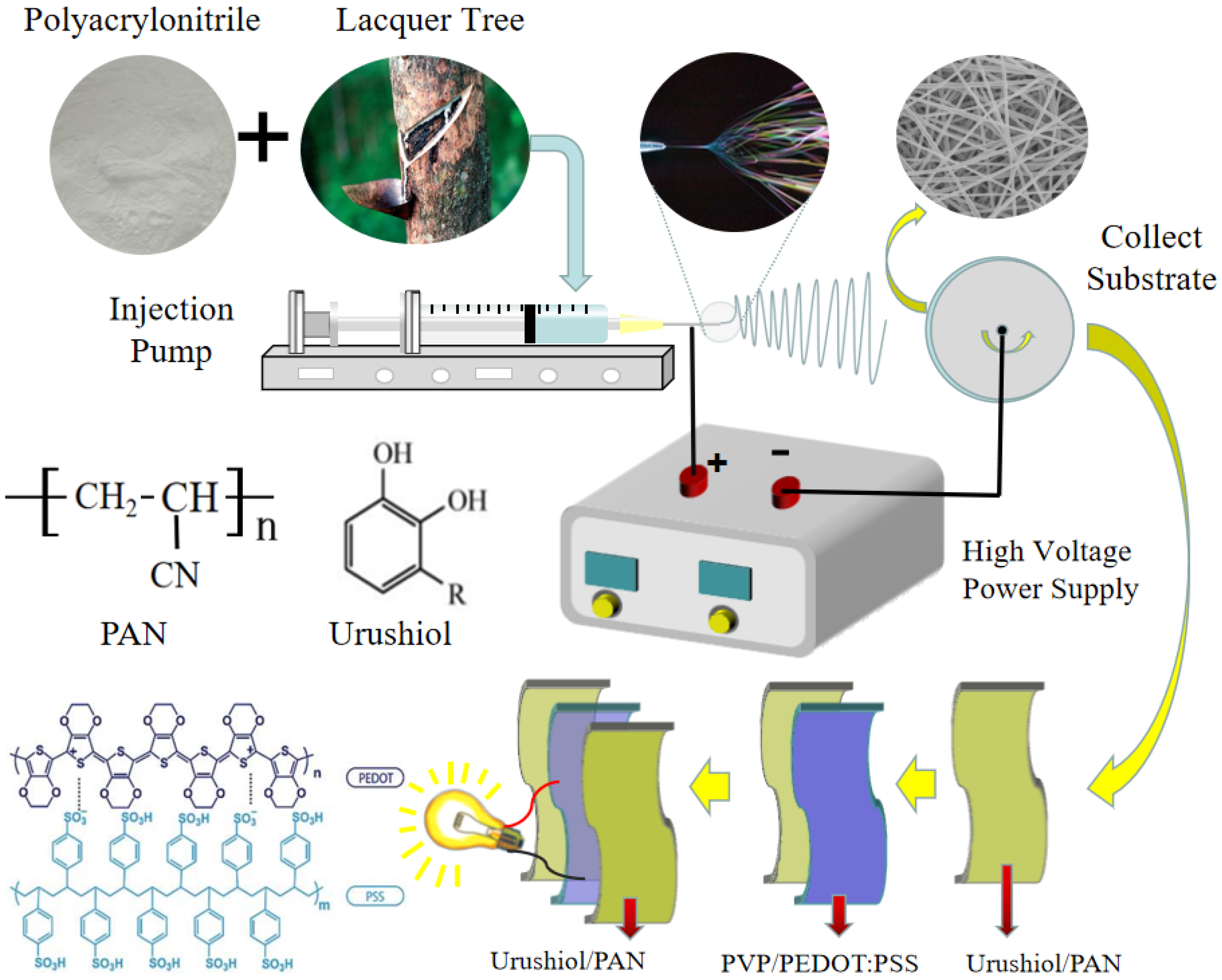


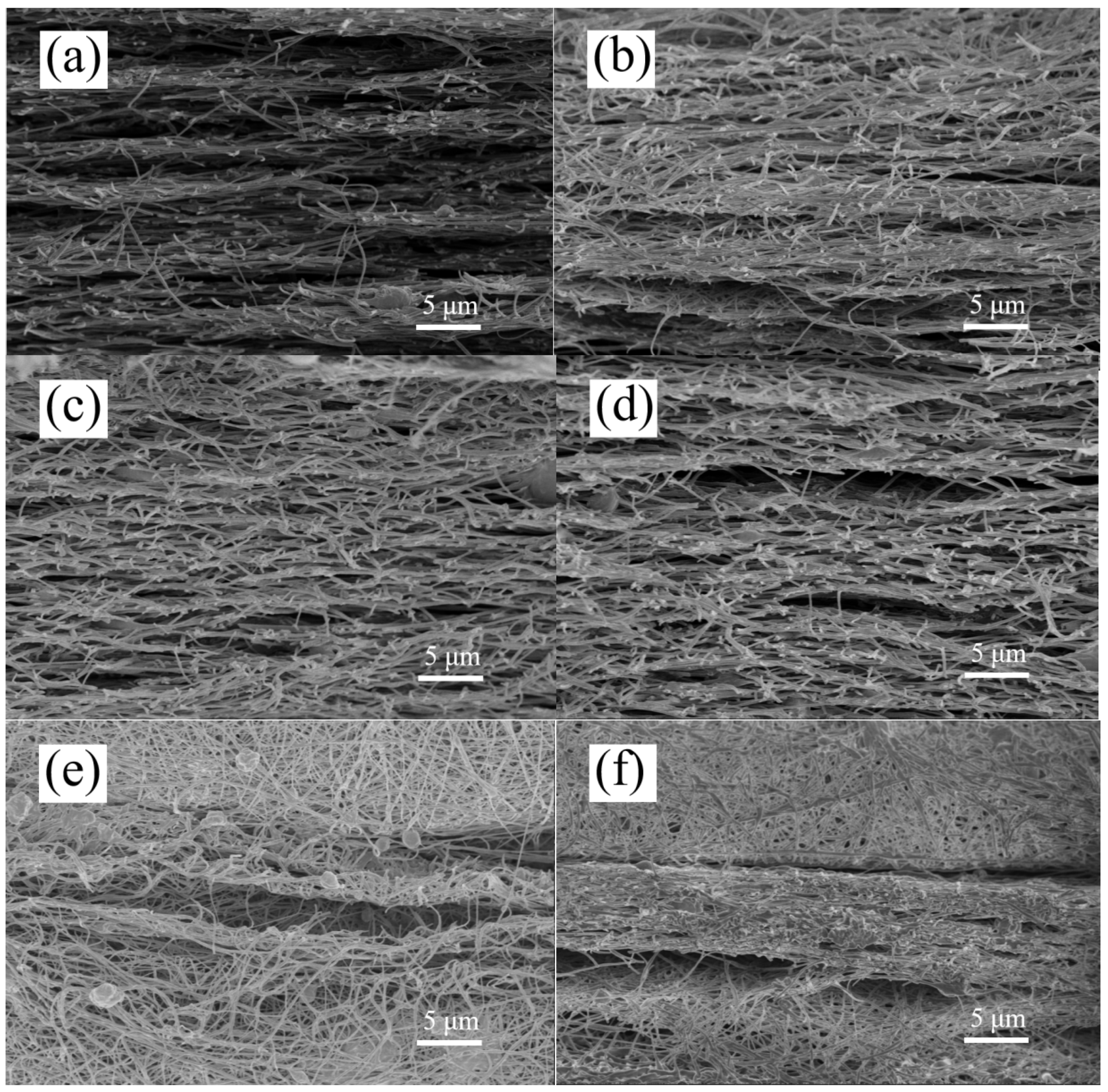
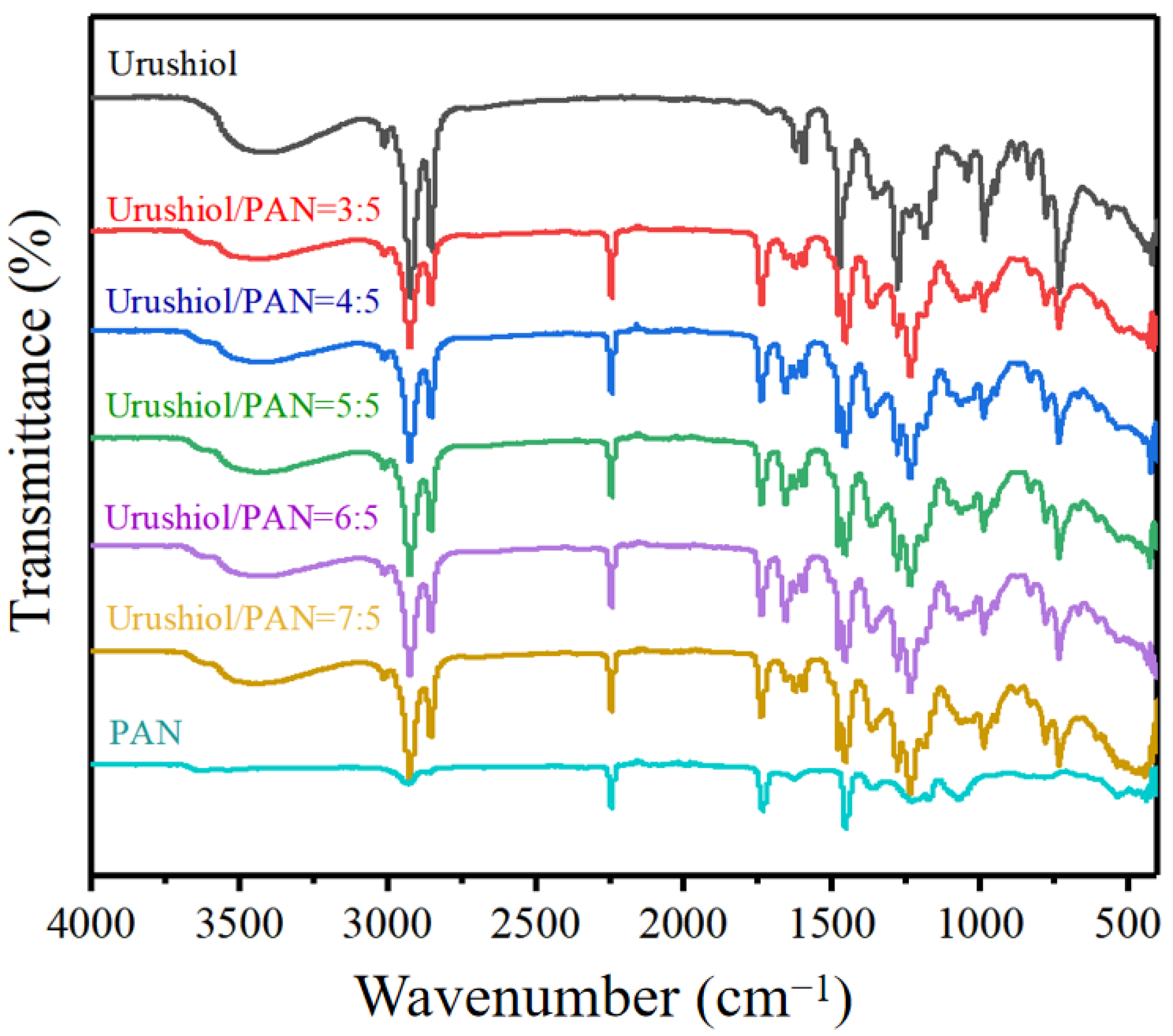
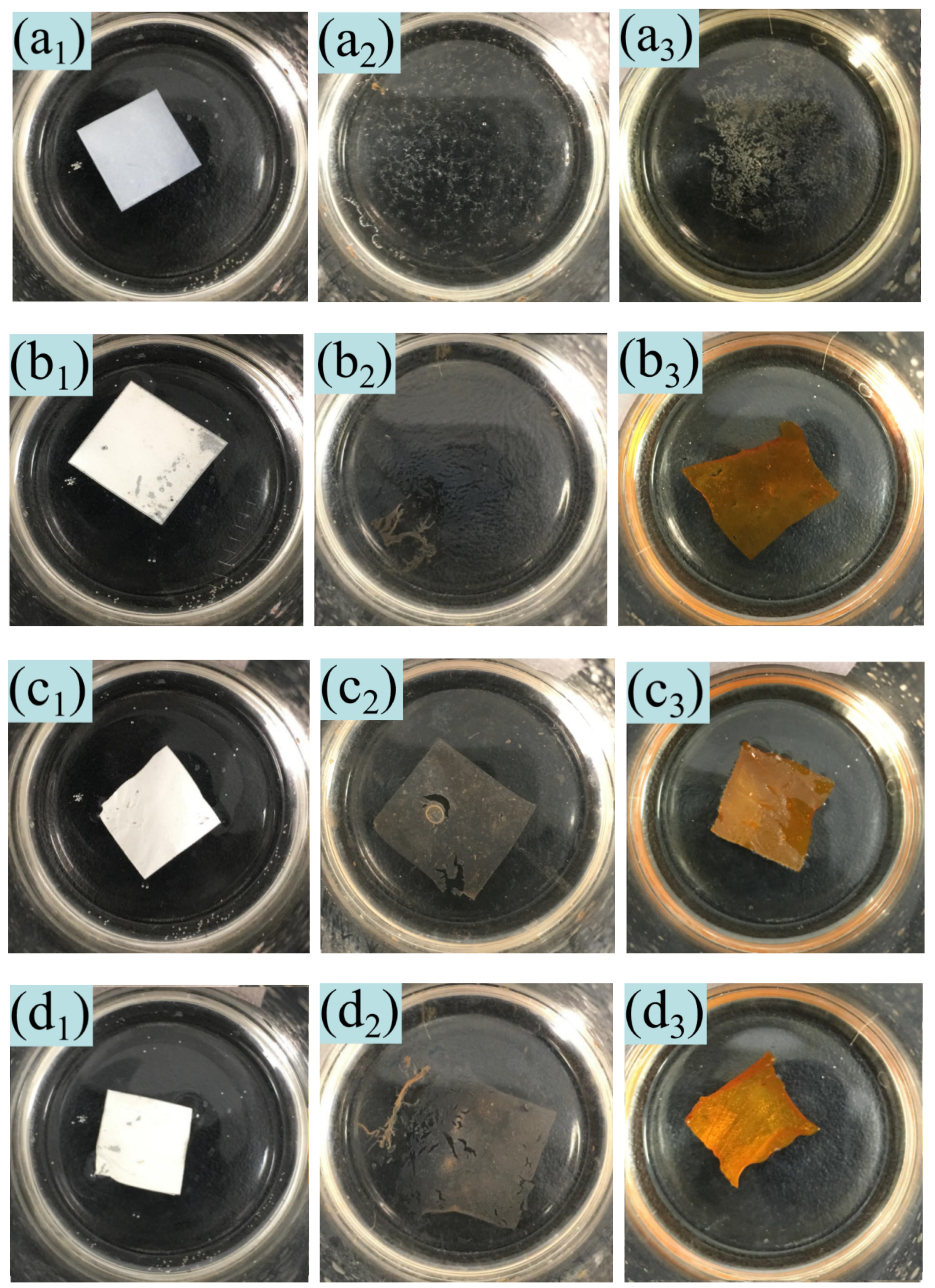
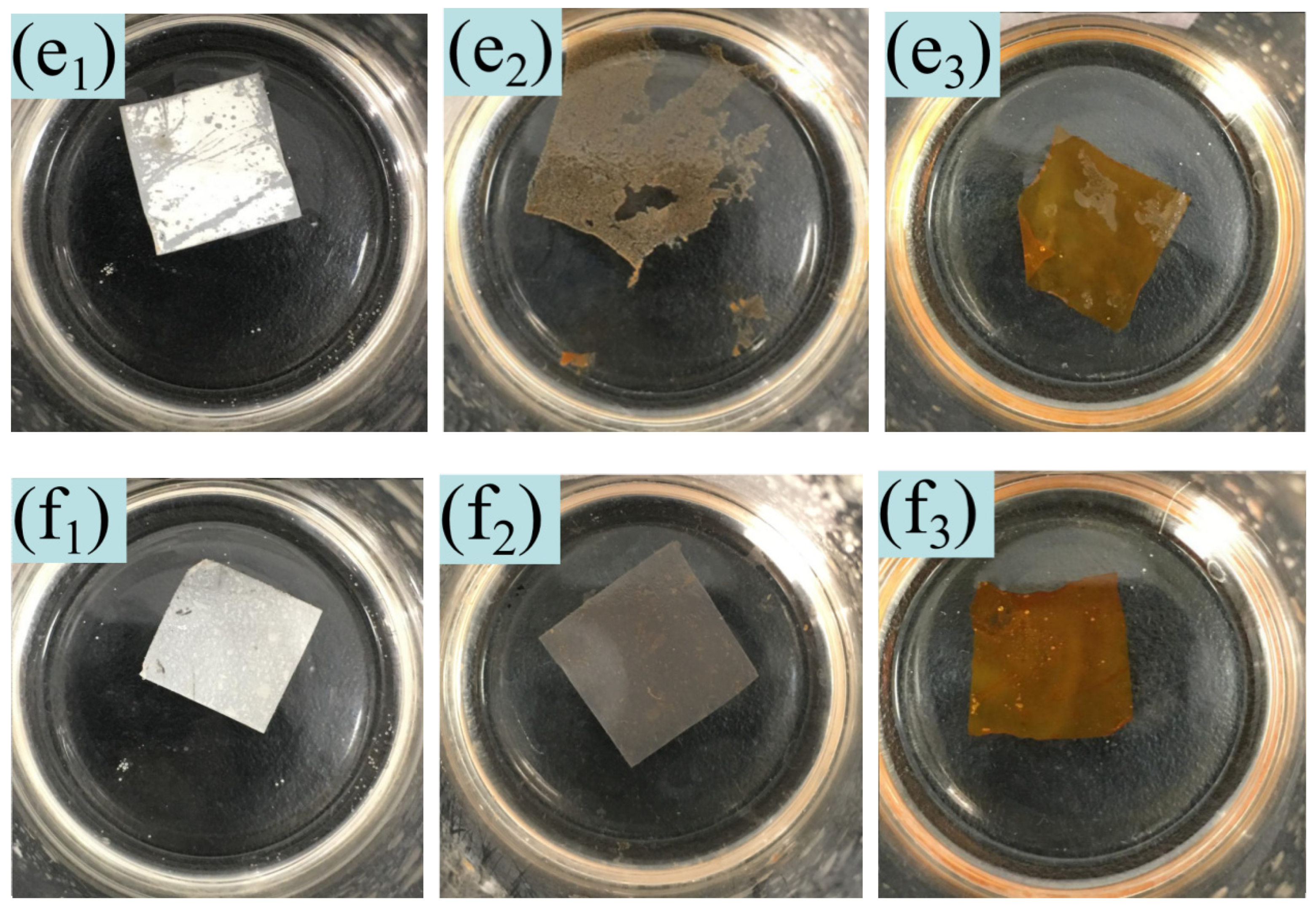
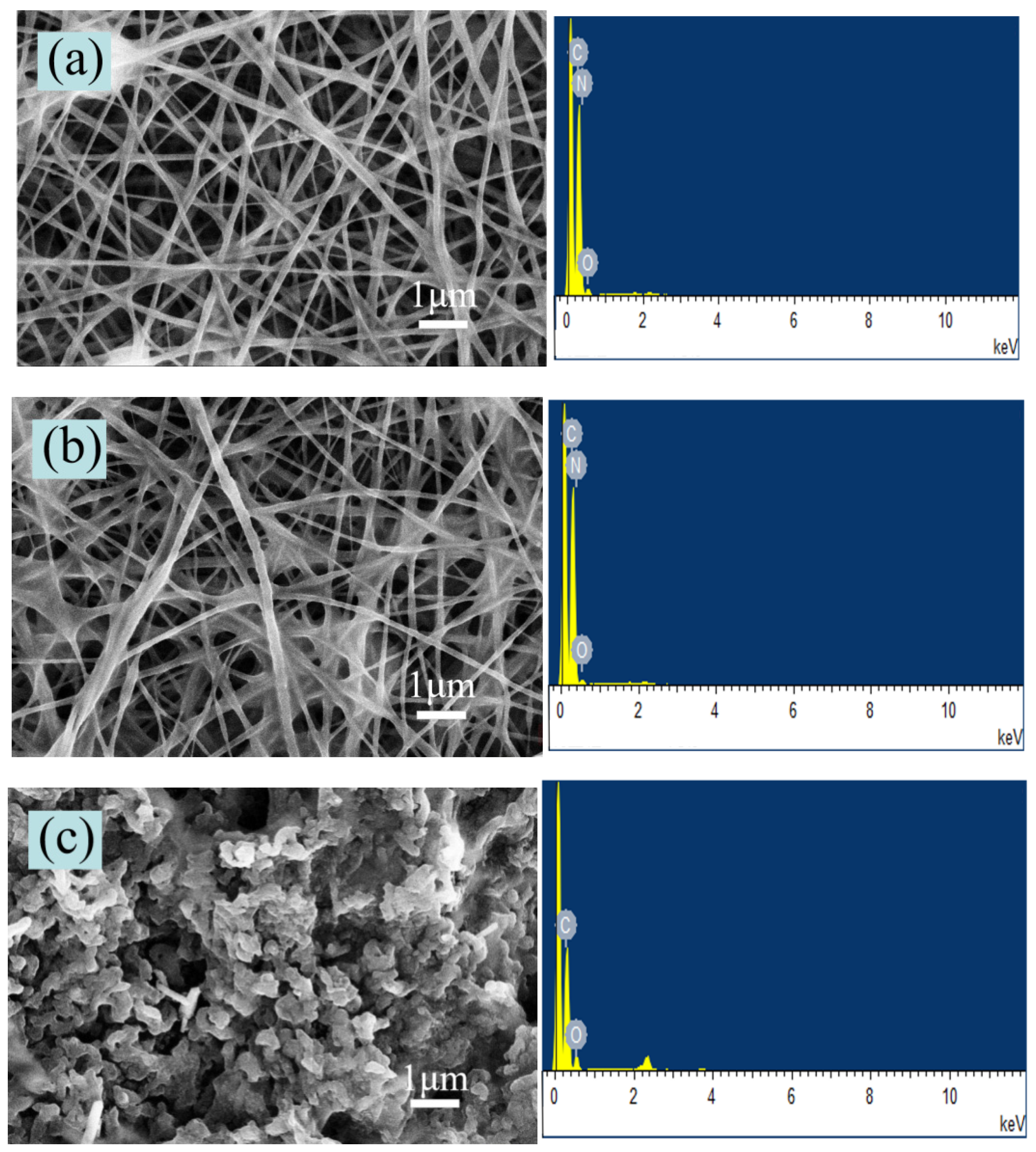
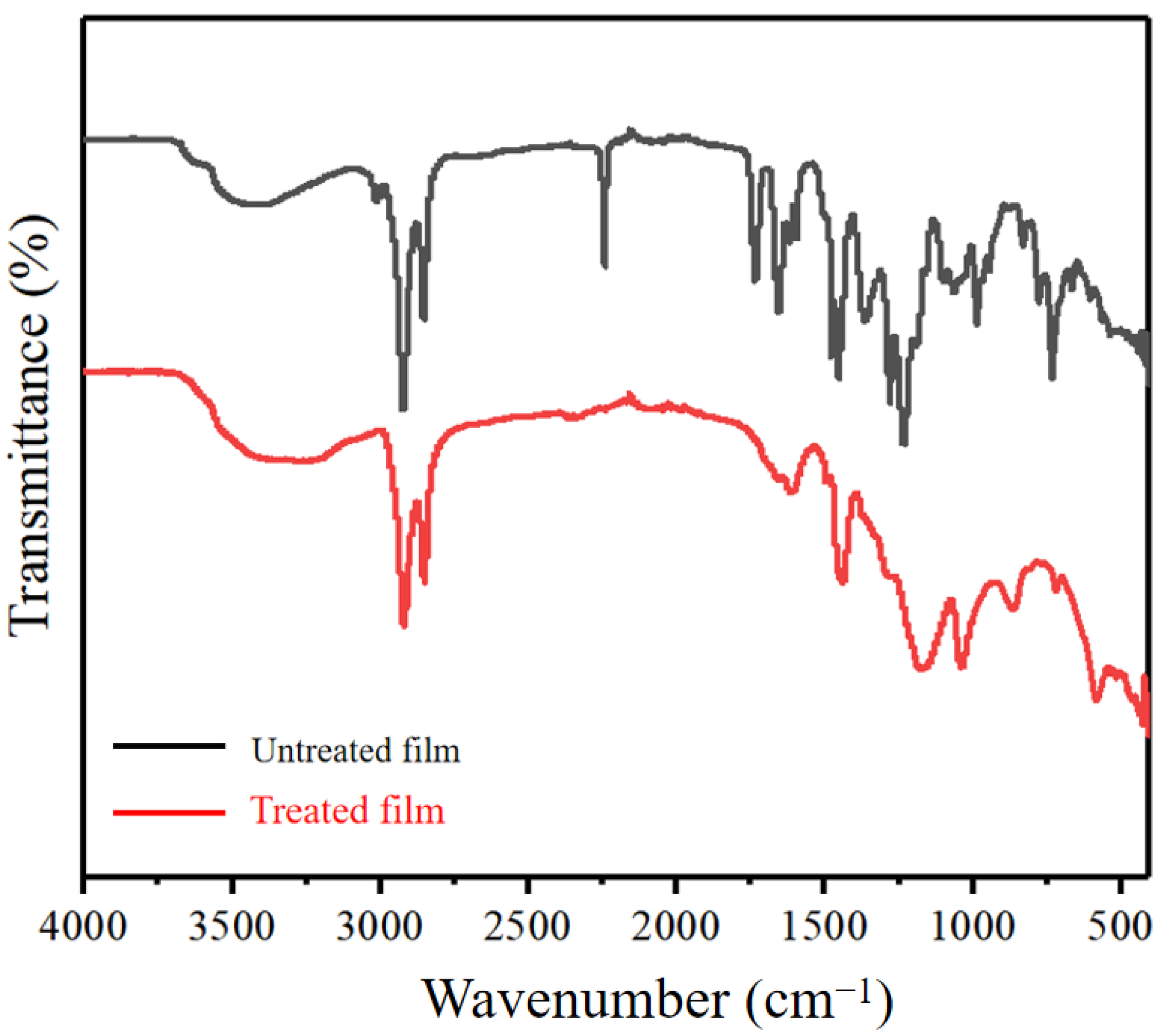
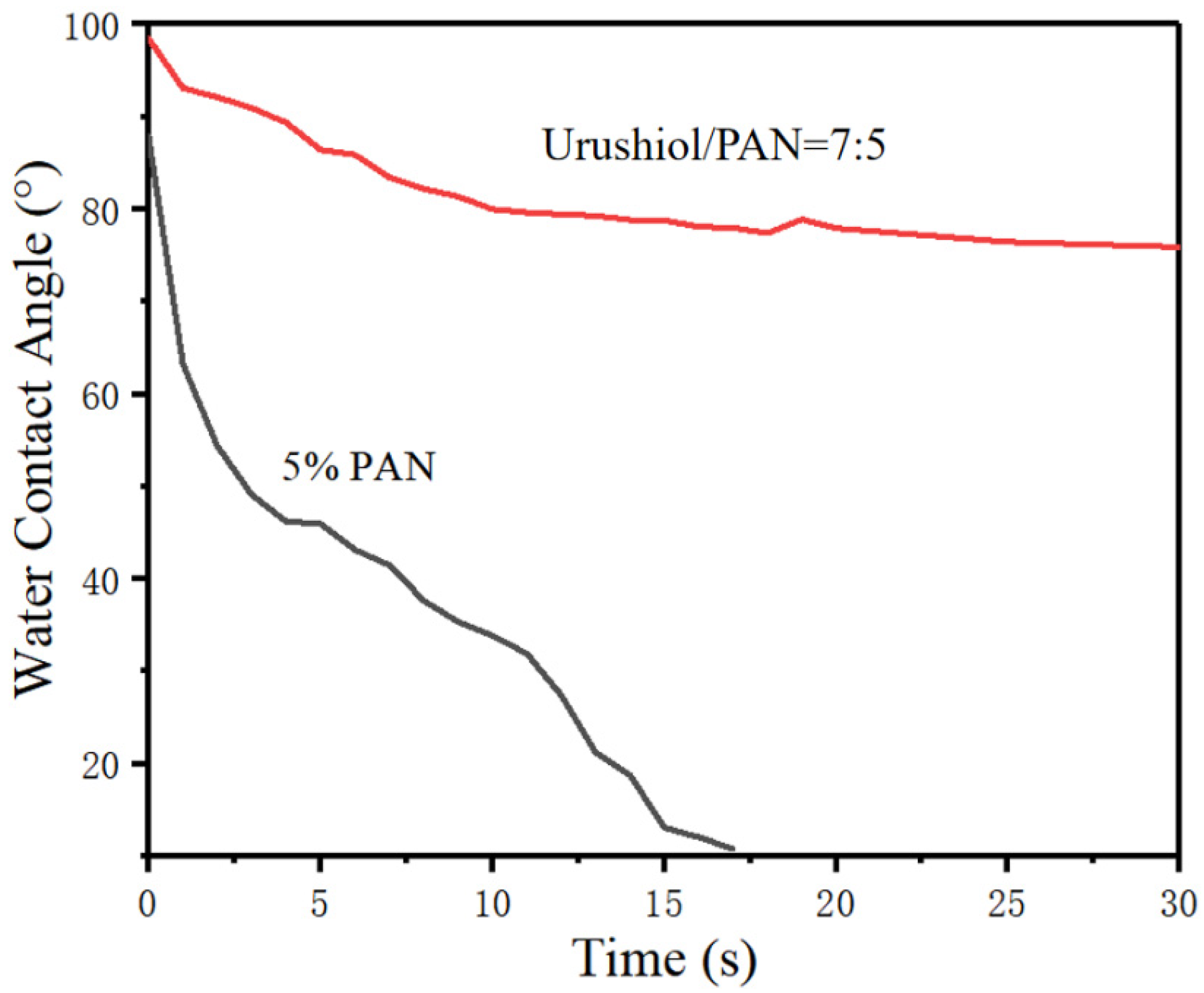

| Urushiol/PAN (g) | Voltage 1 (kV) | Voltage 2 (kV) | Voltage 3 (kV) | The Average (kV) |
| 5% PAN | 29.54 | 27.32 | 27.00 | 27.95 |
| 3:5 | 23.61 | 27.08 | 26.08 | 25.59 |
| 4:5 | 23.65 | 23.53 | 25.02 | 24.06 |
| 5:5 | 23.31 | 23.85 | 23.44 | 23.53 |
| 6:5 | 23.05 | 23.25 | 22.96 | 23.09 |
| 7:5 | 22.31 | 22.36 | 22.79 | 22.49 |
| PEDOT:PSS/PVP (g) | Voltage 1 (kV) | Voltage 2 (kV) | Voltage 3 (kV) | The Average(kV) |
| 4:1 | 27.51 | 28.07 | 27.68 | 27.75 |
| Percentage by Weight | C K | N K | O K |
|---|---|---|---|
| 60% | 66.89 | 23.11 | 10.00 |
| 80% | 71.10 | 20.20 | 8.70 |
| 100% | 76.74 | 0 | 23.26 |
| Urushiol/PAN (g) | Wide (mm) | Thickness (mm) | Peak Load (N) | Tensile Strength (MPa) |
|---|---|---|---|---|
| 5% PAN | 9 | 2.817 × 10−1 | 1.751 | 0.691 |
| 3:5 | 9 | 9.254 × 10−2 | 0.850 | 0.856 |
| 4:5 | 9 | 1.371 × 10−1 | 2.551 | 2.067 |
| 5:5 | 9 | 8.058 × 10−2 | 1.950 | 2.689 |
| 6:5 | 9 | 9.106 × 10−2 | 2.651 | 3.235 |
| 7:5 | 9 | 4.506 × 10−2 | 1.751 | 4.318 |
Publisher’s Note: MDPI stays neutral with regard to jurisdictional claims in published maps and institutional affiliations. |
© 2021 by the authors. Licensee MDPI, Basel, Switzerland. This article is an open access article distributed under the terms and conditions of the Creative Commons Attribution (CC BY) license (https://creativecommons.org/licenses/by/4.0/).
Share and Cite
Wu, K.; Shiu, B.-C.; Zhang, D.; Shen, Z.; Liu, M.; Lin, Q. Preparation of Nanoscale Urushiol/PAN Films to Evaluate Their Acid Resistance and Protection of Functional PVP Films. Nanomaterials 2021, 11, 957. https://doi.org/10.3390/nano11040957
Wu K, Shiu B-C, Zhang D, Shen Z, Liu M, Lin Q. Preparation of Nanoscale Urushiol/PAN Films to Evaluate Their Acid Resistance and Protection of Functional PVP Films. Nanomaterials. 2021; 11(4):957. https://doi.org/10.3390/nano11040957
Chicago/Turabian StyleWu, Kunlin, Bing-Chiuan Shiu, Ding Zhang, Zhenhao Shen, Minghua Liu, and Qi Lin. 2021. "Preparation of Nanoscale Urushiol/PAN Films to Evaluate Their Acid Resistance and Protection of Functional PVP Films" Nanomaterials 11, no. 4: 957. https://doi.org/10.3390/nano11040957
APA StyleWu, K., Shiu, B.-C., Zhang, D., Shen, Z., Liu, M., & Lin, Q. (2021). Preparation of Nanoscale Urushiol/PAN Films to Evaluate Their Acid Resistance and Protection of Functional PVP Films. Nanomaterials, 11(4), 957. https://doi.org/10.3390/nano11040957








